- Home
- Deborah Harkness
The World of All Souls Page 14
The World of All Souls Read online
Page 14
G
BENJAMIN BEN GABRIEL
A friend of Rabbi Loew in Prague and another name under which Benjamin Fox concealed himself.
GALLOWGLASS
Full name: Gallowglass de Clermont
Origin of name: Gallowglasses, meaning “foreign warriors,” were elite mercenaries, drawn largely from Norse-Gaelic clans between the mid-thirteenth and late sixteenth centuries. They were Gaels who had intermarried with the tenth-century Norse settlers of western Scotland.
Date of birth: Unknown
Date of rebirth: Unknown
Physical description: Gallowglass is built like a Viking warrior and looks no more than thirty years old. When Diana thinks of the de Clermont vampires in animal terms, to her Gallowglass is a bear. He has collar-length blond hair, wide blue eyes, a nose that looks like it’s been broken, and tattoos that snake around his body. They tell a complicated tale, changing frequently (tattoos last only a few months on a vampire) depending on his feelings. In the present day he wears scruffy clothes, T-shirts and ripped jeans, and is called Sir Vagabond by Ysabeau.
A member of: The Knights of Lazarus
Family and romantic relationships: Gallowglass is the full-blooded son of Hugh de Clermont and grandson of Philippe de Clermont. He is godfather to Philip Bishop-Clairmont.
Personal history: Gallowglass is a loyal and devoted member of the de Clermont family, despite times when he wishes he had fallen in battle to someone other than Hugh de Clermont. When Hugh gave Gallowglass his new life, Philippe approved his choice. Like Hugh, Gallowglass is a brave and noble warrior who cares little for the practicalities of life, such as running a household.
Gallowglass’s lineage is Norse-Gael, and he mentions that his family was Úlfhéðnar, the legendary Norse “wolf-coat” warriors. He remembers his birth grandfather casting runes and uttering prophecies, and he recalls watching the aurora borealis from the sandy shores where his father lived in the Outer Hebrides on the Isle of Lewis, Scotland. He keeps a small leather pouch of runes, consulting them when he needs a little extra help navigating his future.
When his blood father, Hugh, was executed in France, Gallowglass exacted his revenge on the men who betrayed him. But it was centuries before he would set foot in France again, so deep were his grief and anger. One of Gallowglass’s close companions in arms in the Knights of Lazarus is vampire Davy Gams (Hancock), and they worked together carrying out Matthew’s commands.
Despite Gallowglass’s gnawing wish to belong, he has spent the last few hundred years as a drifter, moving from place to place by sea, rail, and then motorbike, waiting for the signs that he had to return to Sept-Tours. Philippe made him and Verin de Clermont promise to see that Diana was accepted into the family once the time was right. Sadly, Philippe’s command for Gallowglass to watch over Diana until she met Matthew took a toll on his grandson. Gallowglass has been Diana’s secret guardian since her birth, waiting for the day his uncle would meet and marry the woman Gallowglass loved.
DAVY GAM
Full name and other names: Hancock, Sir Dafydd ap Llewelyn ap Hywel, Dafydd Gam
Origin of name: Gam is taken from the Welsh word gam, meaning “lame” or “deformed.”
Date of birth: c. 1380
Date of rebirth: October 27, 1415
Astrological rebirth sign: Scorpio
Physical description: Davy Gam is redheaded, with bushy red eyebrows and the brawny build of a warrior.
A member of: The Knights of Lazarus
Family and romantic relationships: Davy’s birth parentage is of a Welsh noble family in Breconshire who claimed ancient lineage back to the kings of Brycheiniog. Davy’s father was Llywelyn ap Hywel, and his maker was Godfrey de Clermont. Davy is married to a vampire named Bethan, who also goes under the name Lizzie.
Personal history: The name of Davy Gam, friend and companion in arms to Gallowglass, is both revered and reviled in Welsh history, depending on who is telling his story. His family, based in south Wales, had grown in power and influence through loyalty to their English overlords, the Lords of Brecon, from the thirteenth century. There are records of Dafydd and his brother’s allegiance to Henry Bolingbroke as Earl of Brecon and later when he became King Henry IV at the end of the fourteenth century.
When Owain Glyndwr and his men rose up against the English Crown in Wales, Dafydd and his family stayed loyal to their English allies and led the opposition to the rebellion in their area. Initially victorious, Dafydd was later captured by Owain’s men in 1412, and the new young King Henry V paid his ransom swiftly to ensure his safe return. Dafydd’s service to the king then took him to the Battle of Agincourt, where his death is confirmed from many sources. (Legend stipulates this happened while he was saving the king’s life, but it has been widely discounted by historians.) Dafydd is often seen as a figure of the loyal and valiant Welshman, and Davy Gam is named in Shakespeare’s Henry V as one of the noble fallen. His grandson, through his daughter, was William Herbert, who went on to become the powerful 1st Earl of Pembroke.
At Agincourt, Davy was reborn as Hancock, given a new life in service to the de Clermonts and the Knights of Lazarus as the gruff warrior whom Diana met on arriving in England in 1590.
DAVID GANS
Full name: Rabbi Dovid Solomon Ganz
Date of birth: 1541
Physical description: He was around fifty when Diana met him, with a thick gray beard and heavy brow bones that shielded his eyes. His shoulders had the chronic stoop typical of most scholars.
Personal history: When Rabbi Loew took Diana into the Jewish quarter to meet the weaver Abraham, she was greeted by him and his friend David Gans. Gans was an astronomer, a mathematician, and a Jewish chronicler, perhaps most famous today for his history of the Jews, Tzemach David. He is buried in the Old Jewish Cemetery in Prague.
FERNANDO GONÇALVES
Origin of name: Gonçalves is of Portuguese origin, meaning “son of Gonçalo.”
Date of birth: Unknown
Date of rebirth: Unknown
Physical description: Fernando has dark hair and deep brown eyes, with broad shoulders and a fit physique.
A member of: The Knights of Lazarus
Family and romantic relationships: Fernando was Hugh de Clermont’s mate and still considers himself so, despite Hugh’s death. He is close to Hugh’s stepbrother Matthew, as well as Hugh’s son, Gallowglass, and is part of the de Clermont network, though some in the family (including Philippe) did not acknowledge his position as Hugh’s mate. He is godfather to Diana and Matthew’s daughter, Rebecca Bishop-Clairmont.
Personal history: Fernando Gonçalves’s birth family history is hazy, as is the identity of his maker. He had six happy centuries with his mate, Hugh de Clermont, many of which they spent in Córdoba. When Philippe and the de Clermont family became too much for Hugh, he often escaped with Fernando to their homes on the Iberian peninsula.
Fernando is a calm, caring figure, always seeing to other people’s needs. In his relationship with Hugh, Fernando was the one who managed the practical side of their lives, keeping their household running smoothly and making sure Hugh turned up for battle with a sword rather than a book of poetry. Fernando is also a talented cook.
After Hugh died at the beginning of the fourteenth century, Fernando turned down Matthew’s offer to lead the Knights of Lazarus and avoided Sept-Tours. But he always maintained his friendship with Matthew and Gallowglass. Now, as a member of the Bishop-Clairmont scion and godfather to Diana and Matthew’s daughter, he is in the center of a new family.
ISOBEL GOWDIE
Date of birth: c. 1632
A member of: The Auldhearn coven
Family and romantic relationships: Great-grandmother of the modern-day witch Janet Gowdie; lover of vampire Benjamin de Clermont
Personal history: Isobel Gowdie was a witch (and a wea
ver) from Auldhearn in Nairnshire, Scotland. In 1662 she was tried for witchcraft. Rather than denying the charges, she told a colorful story of meeting with a witches’ coven, feasting with the king and queen of the fairies, and being baptized by the devil with her own blood after he sucked it out of her shoulder. Some humans believe she was deluded or psychotic while others believe she made up these stories to avoid torture. Her execution is not recorded, but some stories report that she was strangled (a sign of mercy for having confessed) before being burned at the stake.
Shortly prior to being tried for witchcraft, Isobel Gowdie had a passionate affair with the vampire Benjamin de Clermont and gave birth to the Bright Born child Janet Gowdie. During the trial Isobel reported having had sex with the devil; for anyone acquainted with Benjamin de Clermont, her mistake is understandable.
JANET GOWDIE
Origin of name: Gowdie is an old Scottish name and a variant on Goudie or Goldie.
Date of birth: May 11, 1841
Astrological sign: Taurus
Physical description: Has a broad Scottish accent, an unlined and ageless round face with a dimpled smile, white hair, and twinkling gray eyes
A member of: The Congregation
Family and romantic relationships: Janet’s grandmother Janet Gowdie was a Bright Born, the child of a passionate affair between vampire Benjamin Fox and weaver Isobel Gowdie.
Personal history: Janet Gowdie is a modern witch, well known for her spell-casting abilities and a member of one of the most respected witch families in Scotland. After Peter Knox was forced to leave his seat on the Congregation because of his involvement in Emily Mather’s death, the other witches persuaded Janet Gowdie to come out of semiretirement and take his seat. When Diana appeared at her first Congregation meeting at Isola della Stella, Janet was the only witch there to greet her warmly, and she spoke kindly of Diana’s parents.
Unlike other members of the Congregation, Janet was unsurprised by Diana’s revelations about the existence of Benjamin and his horrifying efforts to create a vampire-witch child by raping a kidnapped witch. This is because Janet, too, knows the secret that the witches discovered long ago: that some witches can conceive a child with vampires who have blood rage and that those children, the Bright Born, are powerful creatures who possess some of the qualities of both parents.
Janet’s great-grandmother Isobel Gowdie was a weaver who’d had a love affair with the vampire Benjamin Fox (though Isobel knew him then as “Nickie-Ben”). Eventually Benjamin moved on, never knowing that he and Isobel had conceived a child. That child was the first Janet Gowdie, and she lived for 250 years. She inherited long life and the terrifying, lethal temper of her vampire father, plus a bit of magic from her mother. The first Janet Gowdie delighted in her Bright Born powers and in the fact that her exploits spawned the legend of the baobhan sith. These were mythological female creatures of the Scottish Highlands who were said to prey upon young men by luring them with magical enchantments, attacking them with sharp talons and sucking their blood. Janet passed her longevity down to her daughter and then on to her granddaughter and namesake, Janet Gowdie of the Congregation, who is still going strong at 169 years of age.
H
ERASMUS HABERMEL
Origin of name: Habermel or Habermehl is of German origin and an occupational name, referring to someone who is a producer or trader in oats (haber).
Date of birth: c. 1538
Physical description: Diana encountered a thin man who had a workman’s scarred hands.
Personal history: An astonishingly prolific instrument maker in the late sixteenth century, Erasmus Habermel was probably born in southern Germany, but not much is known about his background. His beautiful and functional astronomical and mathematical instruments brought him to the attention of Holy Roman Emperor Rudolf II, and Rudolf appointed him royal instrument maker at his court in Prague. There he worked alongside the astronomers, alchemists, and many other artists and instrument makers whom Rudolf had gathered around him.
In Prague, Habermel lived with his wife in the Malá Strana neighborhood, near Diana and Matthew’s home. Soon after the emperor met Diana, he commissioned Habermel to produce an astronomical compendium custom-made to her specifications. Even though Habermel had to guess wildly at the coordinates for the North American colony of Roanoke, Diana appreciated the intricate craftsmanship and utility of Habermel’s compendium. He died in Prague in 1606.
See also: DECORATIVE ARTS: Compendium
TADEÁŠ HÁJEK
Origin of name: Hájek is of Czech origin and an occupational name for a woodman, or someone who lived next to a grove (háj meaning “grove”).
Date of birth: December 1, 1525
Astrological sign: Sagittarius
Physical description: A kindly looking man who was around sixty when Diana met him.
Family and romantic relationships: Tadeáš Hájek, from an old Prague family, had three wives, three sons, and one daughter.
Personal history: Tadeáš Hájek was born in Prague and was a student of botany, astronomy, astrology, mathematics, and medicine. Hájek was active as a lecturer in those fields and corresponded vigorously with other scientists in his city of birth as well as throughout Europe, including John Dee. His scientific interests were varied. For example, he published one of the first books on brewing beer, titled On Beer and the Methods of Its Preparation, Its Substance, Strengths, and Effects, and wrote another that explained how to make medical diagnoses based on a combination of divination and the study of the placement of moles on the body. During his lifetime Hájek was perhaps best known as an astronomer and for his position as physician to the Holy Roman emperor Rudolf II. Hájek met Diana at Rudolf’s palace for the first time, although he was already acquainted with her husband, Matthew.
THOMAS HARRIOT
Origin of name: Harriot is possibly of French origin or Scottish from Heriot.
Date of birth: c. 1560
Physical description: Slender, with a pointed chin, red hair, and a dark complexion
A member of: The School of Night
Family and romantic relationships: He never married and lived with various patrons, including members of the School of Night.
Personal history: Thomas Harriot was a brilliant mathematician and astronomer as well as a talented linguist and alchemist. With a daemonic curiosity, he unfortunately had a habit of making scientific discoveries that he then failed to publish.
Very little is known of Thomas Harriot’s youth or early life before he attended Oxford in 1580. He later moved to London, where he began work for Walter Raleigh and became part of the circle of thinkers and scholars known as the School of Night. Under Raleigh’s employ Harriot soon demonstrated his value as a cartographer and navigational tutor. He also contributed significantly to the design and construction of Raleigh’s ships, in addition to hiring sailors, raising funds, and keeping the accounts for Raleigh’s voyages. In England, Harriot met two native Croatan people, Manteo and Wanchese, who were visiting the country after meeting English explorers in their native land. Harriot learned the Carolinian Algonquin language from Manteo, as well as other information that proved useful to the English colonists. (Wanchese refused to speak with the English, suspicious of their colonial motives.) Harriot visited the English colonies in 1585 and wrote a book, A Briefe and True Report of the New Found Land of Virginia, the only work he published during his lifetime.
As Raleigh’s reputation began to decline after 1592, Harriot was compelled to seek employment elsewhere. He was taken on by another member of the School of Night, Henry Percy, the 9th Earl of Northumberland. But soon after Queen Elizabeth’s death in 1603, Walter Raleigh and then Henry Percy came under suspicion from her successor, King James I. Each was imprisoned in the Tower of London, as was Harriot, albeit more briefly. Throughout his association with Raleigh and Percy, Harriot continued to make significant di
scoveries in the fields of ballistics, navigational techniques, algebra, optics (he discovered the sine law of refraction of light before Snell), and astronomy (he was the first to discover sunspots). Sadly, many of his ideas perished for want of a publisher. Harriot continued to do scientific work up until his death in 1621, but he never published anything more, possibly out of a desire to avoid attention that might land him in the tower again.
Due to the recent, fortunate discovery in the All Souls world of a telescope engraved with Harriot’s name, however, we now have evidence to confirm what many historians of science have long suspected: that Thomas Harriot, not Galileo, created the first telescope in 1591.
VIVIAN HARRISON
Origin of name: Harrison is of Anglo-Saxon origin, meaning “son of Harry” (Harry as an alternative form of Henry).
Date of birth: c. 1960s
Physical description: Shoulder-length silver hair and emerald green eyes
A member of: The Madison Coven
Family and romantic relationships: Vivian’s roots lie in an old Hamilton family from Connecticut. She is married to Roger Harrison, and godmother to Rebecca Bishop-Clairmont.
Personal history: Vivian is a “bulldozer,” according to Sarah Bishop, and a sharp, observant witch. Like the Bishops, the women of her family have kept their name regardless of marriage. Vivian’s husband, Roger, went one step further and changed his last name from Barker to Harrison when they got married, something that has earned him a spot in the Madison coven annals for his willingness to honor tradition.
Vivian is the high priestess of the Madison coven and Sarah’s accountant.
MARGARET HAWLEY
Origin of name: Hawley is of Anglo-Saxon origins and a place-name.

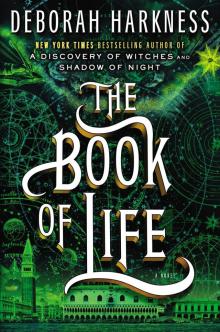 The Book of Life
The Book of Life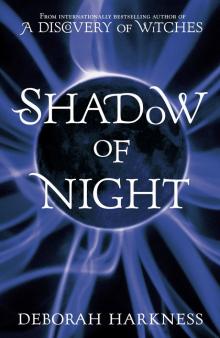 Shadow of Night
Shadow of Night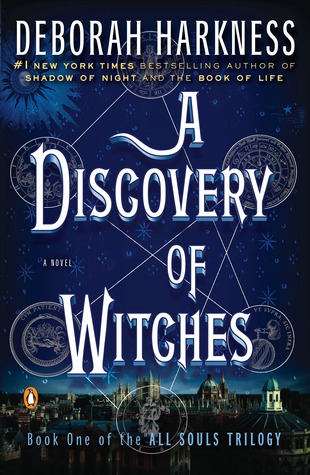 A Discovery of Witches
A Discovery of Witches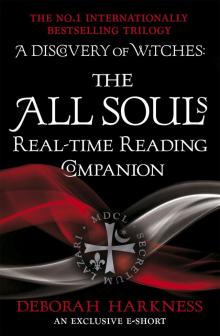 The All Souls Real-Time Reading Companion
The All Souls Real-Time Reading Companion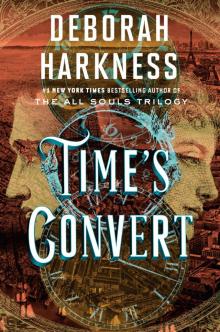 Time's Convert
Time's Convert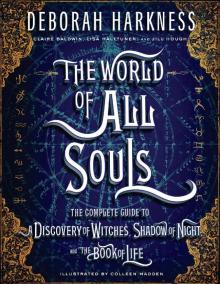 The World of All Souls
The World of All Souls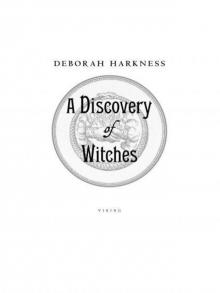 A Discovery of Witches: A Novel (All Souls Trilogy)
A Discovery of Witches: A Novel (All Souls Trilogy) Shadow of Night: A Novel
Shadow of Night: A Novel